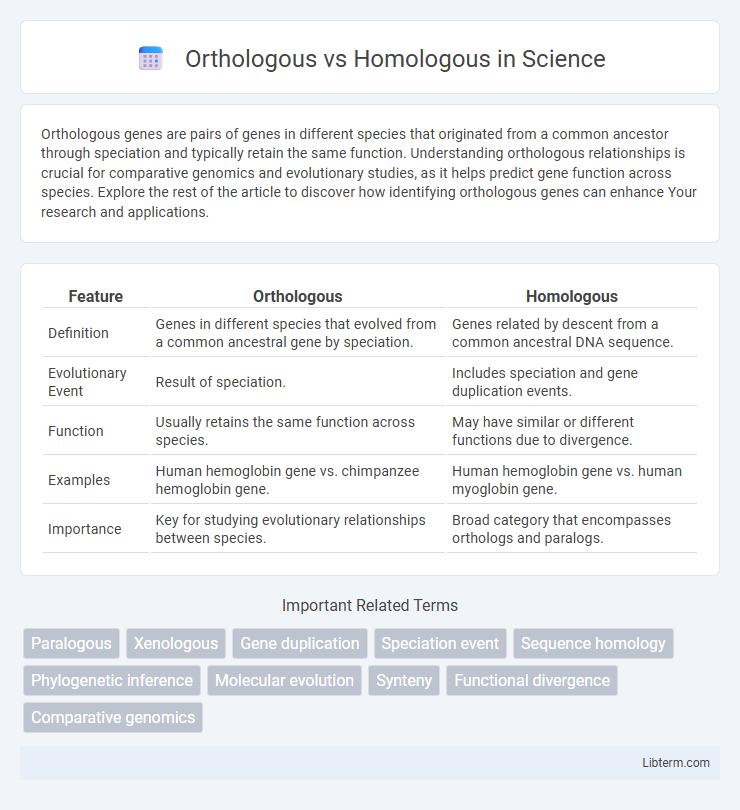Orthologous genes are pairs of genes in different species that originated from a common ancestor through speciation and typically retain the same function. Understanding orthologous relationships is crucial for comparative genomics and evolutionary studies, as it helps predict gene function across species. Explore the rest of the article to discover how identifying orthologous genes can enhance Your research and applications.
Table of Comparison
| Feature | Orthologous | Homologous |
|---|---|---|
| Definition | Genes in different species that evolved from a common ancestral gene by speciation. | Genes related by descent from a common ancestral DNA sequence. |
| Evolutionary Event | Result of speciation. | Includes speciation and gene duplication events. |
| Function | Usually retains the same function across species. | May have similar or different functions due to divergence. |
| Examples | Human hemoglobin gene vs. chimpanzee hemoglobin gene. | Human hemoglobin gene vs. human myoglobin gene. |
| Importance | Key for studying evolutionary relationships between species. | Broad category that encompasses orthologs and paralogs. |
Introduction to Orthologous and Homologous Genes
Orthologous genes are homologous genes found in different species that originated from a common ancestral gene due to speciation events. Homologous genes include both orthologs and paralogs, where paralogs arise from gene duplication within a single species. Understanding the distinction between orthologous and homologous genes is essential for evolutionary biology and functional genomics analyses.
Defining Homology in Genetics
Homology in genetics refers to the similarity between sequences or structures in different species that arises from a common ancestor. Orthologous genes are a specific type of homologs that diverged following a speciation event and typically retain the same function across species. In contrast, homologous sequences encompass both orthologs and paralogs, the latter resulting from gene duplication within a species.
What Are Orthologous Genes?
Orthologous genes are genes in different species that evolved from a common ancestral gene through speciation events, retaining the same function across species. These genes provide critical insights for studying evolutionary relationships and functional genomics by revealing conserved biological processes. Understanding orthologous genes helps in identifying gene function conservation and predicting gene roles in newly sequenced genomes.
Distinguishing Paralogous and Orthologous Genes
Paralogous genes arise from gene duplication events within the same species, leading to gene copies that may evolve new functions, whereas orthologous genes result from speciation events and retain the same function across different species. Identifying orthologs is crucial for comparative genomics and functional annotation, as they reflect evolutionary conservation of gene function. Distinguishing paralogs from orthologs involves phylogenetic analysis and sequence similarity metrics to determine whether gene divergence occurred before or after species divergence.
Evolutionary Significance of Orthologs and Homologs
Orthologous genes arise from speciation events and retain equivalent functions across different species, serving as critical markers for tracing evolutionary relationships and reconstructing phylogenetic trees. Homologous genes encompass both orthologs and paralogs, reflecting common ancestry, but paralogs originate from gene duplication within the same species, often diverging to acquire new functions. Understanding the evolutionary significance of orthologs and homologs enables researchers to decipher gene function conservation, species divergence, and the molecular basis of evolutionary adaptation.
Methods for Identifying Orthologous and Homologous Genes
Identifying orthologous and homologous genes relies on methods such as sequence alignment algorithms like BLAST and tools like OrthoFinder and InParanoid, which compare genomic sequences to detect evolutionary relationships. Phylogenetic tree construction aids in distinguishing orthologs, derived from speciation events, from paralogs, originating from gene duplication within a species. Synteny analysis and clustering of conserved gene neighborhoods further refine detection by confirming gene order conservation across different species.
Functional Implications of Orthology and Homology
Orthologous genes arise from speciation events and typically retain similar functions across different species, providing crucial insights for predicting gene function in evolutionary biology studies. Homologous genes include both orthologs and paralogs, with paralogs resulting from gene duplication and often diverging in function, which complicates functional inference. Understanding orthology is essential for accurate functional annotation in comparative genomics and evolutionary research, while homology broadly indicates shared ancestry but requires careful analysis to discern functional conservation.
Applications in Comparative Genomics
Orthologous genes, derived from a common ancestor through speciation, are crucial for inferring evolutionary relationships and functional conservation across species in comparative genomics. Homologous genes, encompassing both orthologs and paralogs, provide broader insights into gene family evolution and genome duplication events. Analyzing orthologous sequences enhances the accuracy of phylogenetic reconstructions and functional annotations, driving advancements in gene prediction and evolutionary biology research.
Challenges in Ortholog and Homolog Identification
Challenges in ortholog and homolog identification include distinguishing between orthologs and paralogs due to gene duplication events that create complex evolutionary histories. Sequence similarity alone often fails to accurately resolve homologous relationships, requiring integrative approaches combining phylogenetic analysis and synteny data. Incomplete lineage sorting and horizontal gene transfer further complicate precise identification, impacting functional annotation and comparative genomics studies.
Summary: Orthologous vs Homologous Genes in Genomic Research
Orthologous genes are homologous genes found in different species that originated from a common ancestor through speciation, making them essential for studying evolutionary relationships and functional conservation in genomic research. Homologous genes, encompassing both orthologs and paralogs, share a common ancestry but may differ due to gene duplication events, providing insights into gene function diversification. Accurate identification of orthologous versus homologous genes enhances comparative genomics, aiding in the annotation of gene function and evolutionary biology studies.
Orthologous Infographic

 libterm.com
libterm.com